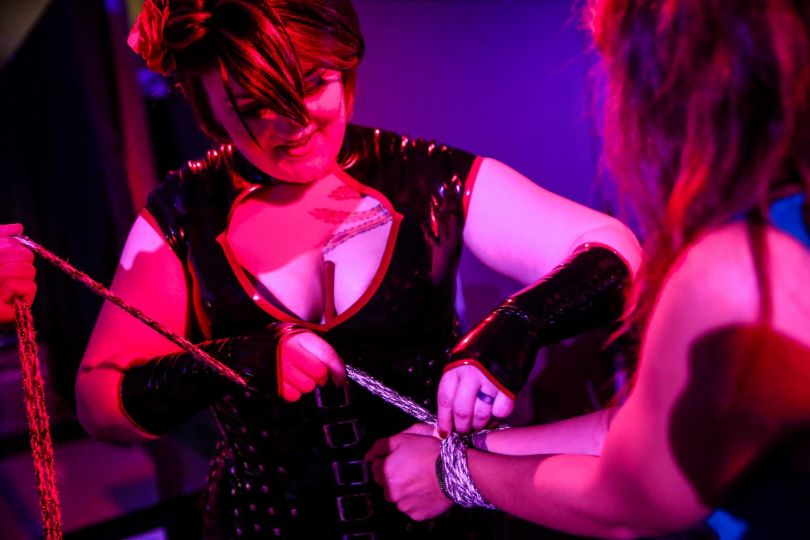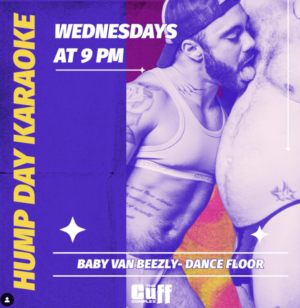Gorgeous vaginas on every wall. Paintings, portraits, sculptures: one mural of labia majora gaped so wide it made me yawn. And the penises! Glass dildos, phallic ink drawings, they dangled from all the slivers of space that the vaginas left behind.
I attended the opening night (a’wink) of this year’s Seattle Erotic Art Festival—it was my first—and like any buffet, the experience was enticing, confusing, and made me think a lot about the choices that led to this moment. For a newbie, it can be intimidating to attend an arts event which displays installations of massive genitals, sculptures of woodland creatures fisting, and live portrayals of bondage and sadism.
At first the space was sparse and my nerves were high, so I got some whisky and headed to an installation booth to get the party started. There, a man in a white lab coat (and only a white lab coat) called himself Dr. No-Pants and explained to me that he and his colleague, Dr. Data, invented a machine that would measure my arousal. Normally I’d be skeptical of nodes being clipped to my ears and a stranger sticking a metal bar under my shirt and onto my nipple, but amidst the scenery of women walking around on stilts and silver lamé, it felt right. He then began asking me a series of questions and my physiological responses were measured as biometric data from the machine he called the “Philometer.” (The valleys on the graph were when he asked me what I’d had for breakfast, if I had a childhood pet, when I last had sex. The spikes on the graph were when my answers consisted of, “water,” “white jerseys,” and “‘Fearful Hunter’ by Jon Macy.” Infer what you will.)
Afterward, I felt somewhat indoctrinated and viewed the space with new eyes. The slender women walking around in short form-fitted dresses and tall heels, the men in leather vests and bowler caps, the bird-masked man slinking between installations while pulling a blue-painted woman in a wagon behind him, I now saw them as fantasies rather than nerds.
Since 2003, this annual event has grown each year in terms of audience and artist submissions. This particular evening’s lineup of live performance art included a stage titled “Sensation City”—hosted by the Center for Sex Positive Culture—upon which you could be casually whipped by a dominatrix in a corset or teased by a man in a black latex suit. There was also a live paint-off auction in which artists would have 15 minutes to finish a painting, then the piece was sold to the highest bidder in the audience. Surrounded by some of the most perfectly-executed artwork I’ve ever seen, amidst sounds of yelps and laughter, I began to understand the appeal of SEAF.
Erotica itself often feels novel due its sense of danger. It lends itself to a naughty sense of getting caught, the guilty pleasure of indulging in “sin.” This feeling alone can be exciting, but events like SEAF shed light on a broader idea: human sexuality is something to be celebrated. While cultural celebrations like Pride parades usually focus on eradicating shame from our general identity and orientation, erotic art helps to eradicate the shame of sexual desire itself.
But erotica is often shunned as an “extreme” form of depiction. People feel more comfortable about their own kinky quirks if they can distance themselves from something even more risqué, i.e. someone who enjoys pegging might feel more secure comparing themselves to someone who likes to be bound, flogged, and threaded with needles.
Personally, it made me supremely uncomfortable seeing photos of women wrapped in plastic body bags, or to see images of skin being cut or pierced, or to see men tied to chairs and gagged. I was uncomfortable because I associate these actions with violence, rape, and the most monstrous aspects of human nature. But acknowledging my own aversive response and realizing that the subjects were consensual participants forced me to challenge my own concerns. I was afraid of these images because I assumed they meant pain and torture. When I viewed them as moments between willing parties, I began to see the revolutionary beauty behind re-appropriating what could be perceived as violence and turning it into an act of pleasure, an act of love.
Effective art engages its audience and urges them to feel something. Erotic art, which stimulates our most primal compulsions, poises itself to be the most effective art of all. It triggers the reptilian pieces of our brains and polarizes our perception between fear and lust, pleasure and pain, resistance and submission.
The LGBT community is well-positioned to free ourselves from standardized sexual expectations and enjoy erotic art based on the fact that our sexual orientations, or our bodies themselves, already challenge heteronormativity. But queer or otherwise, visual erotica can stimulate new sides of our sexualities through images, and erotic literature can guide our imaginations to create our own mental scenes, evoking new emotions and helping us overcome our own insecurities or restrictions.
Big fan of erotica? Think anyone who endorses this smut is going to hell in a hand-basket? Hit us up on social media, comment below, or email me at ryan@seattlegayscene.com.


























While I won’t be writing a full-on piece about SEAF, I would like to add that what I gleaned was also a major sense of female/feminine empowerment. The booth I enjoyed knowing of the most was where people could pose naked and be drawn, at their choosing. Not only was there an awakening of different kinds of sexualities and interestst, but there was also a sense of empowering people to be comfortable in their own skins. So often we are body shamed, or we let our anxieties override our own beautiful forms. But through sex and the right sexual partners, we can become more confident and self-fulfilled humans.
Absolutely, Korra. It was wonderful to see a celebration of female sexuality and the empowerment of women. The SEAF board did an excellent job creating a balanced, affirming space.